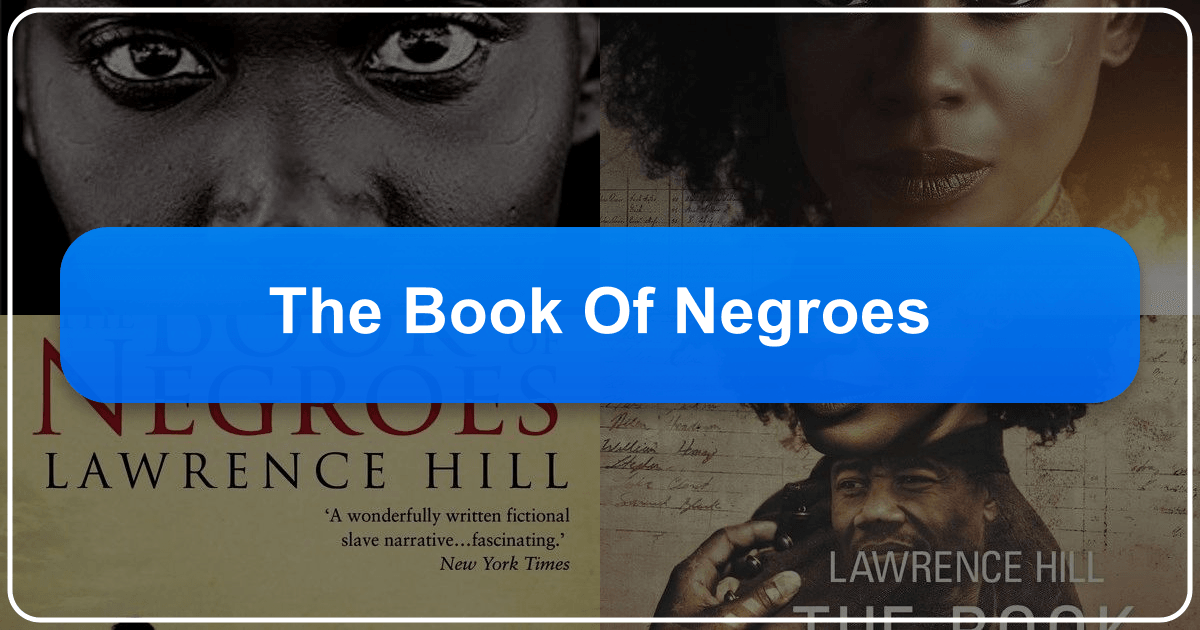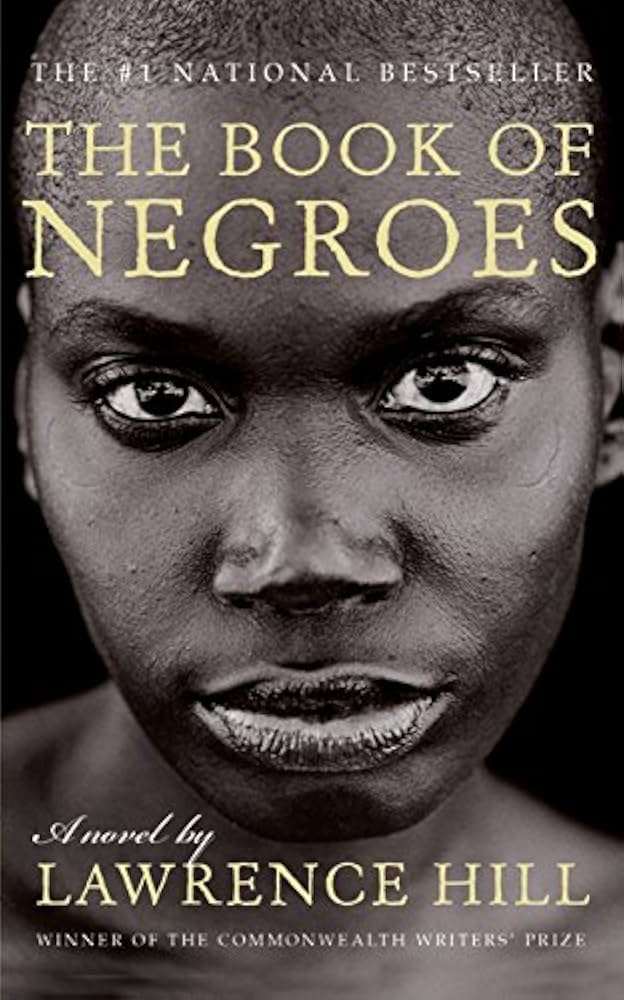*The Book of Negroes*: A Comprehensive Overview

The Book of Negroes, a powerful work of historical fiction by Lawrence Hill, has garnered significant acclaim since its publication in 2007. Originally titled Someone Knows My Name in certain regions, the novel has resonated deeply with readers and critics alike, prompting adaptations and sparking important conversations about slavery and the enduring impact of historical injustices. This article explores The Book of Negroes through various lenses, examining its literary merit, historical context, and broader cultural influence, aligning with common topics found on book-related websites.

1. Books: Genre, Themes, and Impact
The Book of Negroes is primarily categorized as historical fiction, yet it transcends the genre’s typical boundaries. While meticulously researched and grounded in historical reality, including the actual “Book of Negroes” document, it tells a fictional narrative centered around Aminata Diallo, a woman’s journey through the horrors of the transatlantic slave trade. This blending of fact and fiction allows Hill to explore profound themes that resonate far beyond its historical setting.
The central themes explore the profound inhumanity of the slave trade, demonstrating its impact on the physical, sexual, emotional, psychological, religious, and economic aspects of Aminata’s life and the lives of countless others. The novel doesn’t shy away from graphic depictions of the brutality and degradation inherent in the system, emphasizing the systematic dehumanization inflicted upon enslaved Africans. Beyond the horrors of captivity, The Book of Negroes also highlights themes of resilience, survival, community, and the enduring strength of the human spirit. Aminata’s determination to maintain her identity, preserve her cultural heritage, and ultimately fight for her freedom serves as a testament to the unwavering spirit of those who suffered under slavery.

Furthermore, the novel explores the complexities of identity, examining how Aminata’s experiences shape her understanding of herself and her place in the world. Her constant migration across continents and cultures forces her to adapt and re-invent herself repeatedly. This migratory experience, both involuntary and voluntary, becomes a central motif of the narrative, highlighting the disruption and displacement caused by the slave trade, while underscoring the enduring desire for home and belonging. The novel’s impact lies in its ability to humanize the victims of this horrific system, compelling readers to confront the painful realities of the past and consider the lasting ramifications in the present.

2. Authors: Lawrence Hill and his Literary Style
Lawrence Hill, the author of The Book of Negroes, is a celebrated Canadian author known for his ability to weave historical narratives with compelling fictional stories. His distinctive style combines thorough research with imaginative storytelling, creating a tapestry of historical accuracy and emotional depth. Hill’s background, as a person of mixed race, uniquely informs his perspective and imbues the novel with a sensitivity and understanding that adds layers of complexity to the narrative.
The novel’s strength lies in Hill’s masterful prose, creating a first-person account that captures Aminata’s voice with authenticity and emotional resonance. Aminata’s experiences are relayed in a direct, uncomplicated manner, yet her inner thoughts and feelings are conveyed with subtlety and insight. This creates a compelling reading experience that keeps the reader captivated from start to finish.
2.1. Hill’s Inspirations and Influences:
Hill’s inspiration comes from the actual “Book of Negroes,” a historical document recording the names of Black Loyalists who sought refuge in Canada after the American Revolution. This real-world document provides the foundational framework for the novel’s plot, allowing Hill to create a fictional character whose journey reflects the collective experiences of thousands of Black Loyalists. The novel also draws heavily upon other existing forms of storytelling, such as slave narratives, which shaped the style and structure of the novel.
The first-person perspective, a common trope in slave narratives, allows Aminata’s voice to directly speak to readers, thus imparting the urgency and raw emotion of her experiences. The narrative style uses Aminata’s story to explore a period in history that often goes unmentioned, but the narrative’s exploration gives profound insight into the lives of those enslaved. The blend of historical accuracy and fictional storytelling is also an important aspect of Hill’s work. By incorporating factual events and figures into the story, the author creates a realistic and immersive experience that deepens the emotional impact of the novel.
3. Reading and Learning: Summaries, Educational Value, and Life Lessons
The Book of Negroes provides more than just an entertaining read; it offers significant educational value and serves as a conduit for vital life lessons. The novel’s summary reveals Aminata’s incredible journey from her abduction in Africa to her eventual resettlement in Sierra Leone and involvement in the abolitionist movement in Britain. This journey traces the human cost of slavery and colonialism, providing readers with a detailed and immersive insight into an often-overlooked period in history.
3.1. Educational Value and Life Lessons:
The novel’s most profound educational contribution stems from its detailed portrayal of the transatlantic slave trade, moving beyond simplistic accounts of cruelty to depict the everyday realities, resilience, and systematic oppression faced by enslaved people. It not only educates readers about the historical context of the “Book of Negroes” and the Black Loyalists’ experiences but also challenges preconceived notions about slavery and its enduring legacy. Hill’s meticulous research creates an authentic portrayal of the complexities of slavery, revealing the economic structures, political forces, and social norms that maintained the system.
The life lessons that emerge from Aminata’s story resonate far beyond its historical context. Her resilience and unwavering determination in the face of unimaginable adversity highlight the importance of perseverance and hope. The novel underscores the power of community and mutual support in overcoming obstacles, emphasizing the strength that comes from solidarity and collective action. Aminata’s journey illustrates the importance of education and literacy, and how these tools empower individuals to fight for their rights and dignity. Ultimately, The Book of Negroes serves as a reminder of the importance of understanding and confronting the injustices of the past to build a more equitable future.
4. Libraries: Preservation and Access
The enduring legacy of The Book of Negroes is inextricably linked to libraries and archives. The very existence of the “Book of Negroes” as a historical document emphasizes the significance of archival preservation. Libraries, both physical and digital, play a vital role in making this and other such historical records accessible to a wider audience, fostering historical literacy and critical awareness. The novel itself encourages readers to explore related historical materials. The Book of Negroes illustrates the importance of using library and archival research in creative works. The resources available in libraries allow for the detailed exploration of history and the creation of realistic and meaningful narratives.
4.1. Digital Libraries and Accessibility:
In the digital age, online libraries and digital archives are crucial in disseminating knowledge and promoting accessibility. Online versions of The Book of Negroes increase the novel’s global reach, broadening its readership and fostering conversations across diverse communities. Digital platforms also enable interactive learning experiences, allowing readers to engage with historical context, author biographies, and related scholarship in a dynamic and interactive manner. The existence of digital resources makes it easier to access the information needed to understand the novel’s historical background. The combination of digital and print resources allows for a richer and more comprehensive engagement with the themes and message within The Book of Negroes.
5. Cultural Impact: Adaptations, Awards, and Communities
The Book of Negroes has had a significant cultural impact, extending beyond its literary merit. Its adaptation into a highly successful miniseries broadened its reach, fostering dialogue across various communities and solidifying its place in popular culture.
5.1. Awards and Critical Acclaim:
The novel has received numerous awards, including the prestigious Commonwealth Writers’ Prize, a testament to its literary quality and impact. This award, and the other significant recognition received, further solidified its position as an important literary work, contributing to the ongoing discussion about slavery and the enduring need for social justice. The awards received, and the critical acclaim given to The Book of Negroes, have ensured its continued relevance in contemporary literature and conversations about the past and the present.
5.2. Miniseries Adaptation and Literary Influence:
The television miniseries adaptation of The Book of Negroes significantly amplified the book’s reach, bringing the narrative to a wider audience and generating further discussion about the themes of slavery, freedom, resilience, and identity. The miniseries adaptation illustrates the continuing power of The Book of Negroes and its impact on contemporary culture. The ability of the novel to serve as a catalyst for public engagement with the themes discussed demonstrates the lasting significance of the book.
The Book of Negroes has also influenced other works of literature and media, inspiring new narratives and scholarship that engage with similar themes and historical contexts. Its enduring impact on cultural conversations attests to the novel’s power to stimulate critical examination of the past and inspire action toward a more just future. The continued exploration of these themes across various media emphasizes the lasting legacy of Lawrence Hill’s work and its ability to shape cultural conversations for generations to come. The novel’s ability to resonate with readers and viewers across various media demonstrates its enduring power as a work of both historical and literary importance.